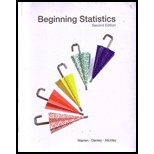
Hypothesis Testing using Analysis of Variance i.e. ANOVA.
Answer to Problem 4CR
Solution:
The null hypothesis is rejected and it is concluded that at least one of the tables is not generating the same
| SS | df | MS | F | |
| Treatments (T) | 3 | 555111578.33 | 67.05 | |
| Error (E) | 16 | 827856.38 | ||
| Total | 179780437 | 19 |
Explanation of Solution
Given:
The amount of revenue (in whole dollars) received during one particular three-hour period is recorded at each table each night for five nights.
| Revenue (in Dollars) | |||
| Table 1 | Table 2 | Table 3 | Table 4 |
| 8534 | 9821 | 10, 542 | 7367 |
| 7845 | 8997 | 9982 | 8021 |
| 8901 | 7905 | 8934 | 9034 |
| 9371 | 8923 | 9344 | 6703 |
| 7782 | 6675 | 8745 | 8432 |
Formula Used:
Grand Mean is the weighted mean of the
Sum of Squares among Treatments (SST) is the measures the variation between the sample means and the grand mean, given by,
Sum of Squares for Error (SSE) is the measures the variation in the sample data resulting from the variability within each sample,
Total Variation, it is the sum of the squared deviations from the grand mean for all of the data values in each sample, given by
Mean Square for Treatments (MST) found by dividing the sum of squares among treatments by its degrees of freedom, given by
Mean Square for Error (MSE) found by dividing the sum of squares for error by its degrees of freedom, given by
Test Statistic for an ANOVA Test: Used when independent, simple random samples are taken from populations with variances that are unknown and assumed to be equal, where all of the
Rejection Region for ANOVA Tests: Reject the null hypothesis,
ANOVA Table is formed as,
| SS | df | MS | F | |
| Treatments (T) | SST | DFT | ||
| Error (E) | SSE | DFE | ||
| Total | SST+SSE | DFT+DFE |
Calculation:
The grand Mean is,
From the table, substitute the following values as,
Sum of Squares among Treatments (SST) is given as,
From the table, substitute the following values as,
Sum of Squares for Error (SSE) is given as,
Substitute the following values as,
The total Variation is given as,
Substitute the following values as,
The mean Square for Treatments (MST) is,
with degree of freedom as
The mean Square for Error (MSE) is,
with degree of freedom as
The test Statistic for an ANOVA Test:
with degree of freedoms as 3 and 16.
Let Table 1, Table 2, and Table 3 and Table 4 be the population 1, 2, 3 and 4 respectively and let
Let the null and alternative hypothesis for this test is
H1: At least one mean revenue is different from others
Level of significance is 0.05, thus
Want to see more full solutions like this?
Chapter 11 Solutions
Beginning Statistics, 2nd Edition
- A company found that the daily sales revenue of its flagship product follows a normal distribution with a mean of $4500 and a standard deviation of $450. The company defines a "high-sales day" that is, any day with sales exceeding $4800. please provide a step by step on how to get the answers in excel Q: What percentage of days can the company expect to have "high-sales days" or sales greater than $4800? Q: What is the sales revenue threshold for the bottom 10% of days? (please note that 10% refers to the probability/area under bell curve towards the lower tail of bell curve) Provide answers in the yellow cellsarrow_forwardFind the critical value for a left-tailed test using the F distribution with a 0.025, degrees of freedom in the numerator=12, and degrees of freedom in the denominator = 50. A portion of the table of critical values of the F-distribution is provided. Click the icon to view the partial table of critical values of the F-distribution. What is the critical value? (Round to two decimal places as needed.)arrow_forwardA retail store manager claims that the average daily sales of the store are $1,500. You aim to test whether the actual average daily sales differ significantly from this claimed value. You can provide your answer by inserting a text box and the answer must include: Null hypothesis, Alternative hypothesis, Show answer (output table/summary table), and Conclusion based on the P value. Showing the calculation is a must. If calculation is missing,so please provide a step by step on the answers Numerical answers in the yellow cellsarrow_forward
 MATLAB: An Introduction with ApplicationsStatisticsISBN:9781119256830Author:Amos GilatPublisher:John Wiley & Sons Inc
MATLAB: An Introduction with ApplicationsStatisticsISBN:9781119256830Author:Amos GilatPublisher:John Wiley & Sons Inc Probability and Statistics for Engineering and th...StatisticsISBN:9781305251809Author:Jay L. DevorePublisher:Cengage Learning
Probability and Statistics for Engineering and th...StatisticsISBN:9781305251809Author:Jay L. DevorePublisher:Cengage Learning Statistics for The Behavioral Sciences (MindTap C...StatisticsISBN:9781305504912Author:Frederick J Gravetter, Larry B. WallnauPublisher:Cengage Learning
Statistics for The Behavioral Sciences (MindTap C...StatisticsISBN:9781305504912Author:Frederick J Gravetter, Larry B. WallnauPublisher:Cengage Learning Elementary Statistics: Picturing the World (7th E...StatisticsISBN:9780134683416Author:Ron Larson, Betsy FarberPublisher:PEARSON
Elementary Statistics: Picturing the World (7th E...StatisticsISBN:9780134683416Author:Ron Larson, Betsy FarberPublisher:PEARSON The Basic Practice of StatisticsStatisticsISBN:9781319042578Author:David S. Moore, William I. Notz, Michael A. FlignerPublisher:W. H. Freeman
The Basic Practice of StatisticsStatisticsISBN:9781319042578Author:David S. Moore, William I. Notz, Michael A. FlignerPublisher:W. H. Freeman Introduction to the Practice of StatisticsStatisticsISBN:9781319013387Author:David S. Moore, George P. McCabe, Bruce A. CraigPublisher:W. H. Freeman
Introduction to the Practice of StatisticsStatisticsISBN:9781319013387Author:David S. Moore, George P. McCabe, Bruce A. CraigPublisher:W. H. Freeman





